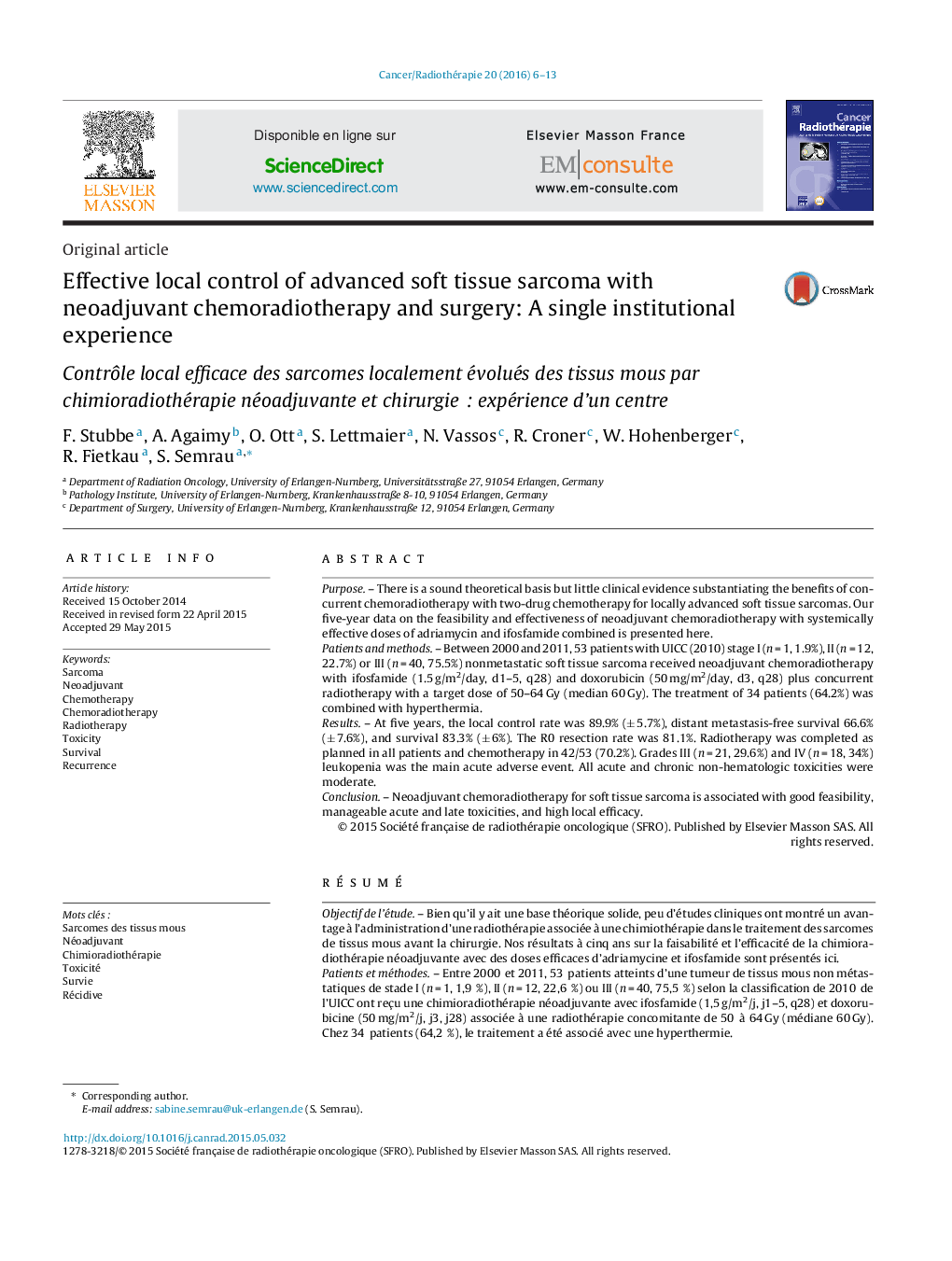| Article ID | Journal | Published Year | Pages | File Type |
|---|---|---|---|---|
| 2117037 | Cancer/Radiothérapie | 2016 | 8 Pages |
PurposeThere is a sound theoretical basis but little clinical evidence substantiating the benefits of concurrent chemoradiotherapy with two-drug chemotherapy for locally advanced soft tissue sarcomas. Our five-year data on the feasibility and effectiveness of neoadjuvant chemoradiotherapy with systemically effective doses of adriamycin and ifosfamide combined is presented here.Patients and methodsBetween 2000 and 2011, 53 patients with UICC (2010) stage I (n = 1, 1.9%), II (n = 12, 22.7%) or III (n = 40, 75.5%) nonmetastatic soft tissue sarcoma received neoadjuvant chemoradiotherapy with ifosfamide (1.5 g/m2/day, d1–5, q28) and doxorubicin (50 mg/m2/day, d3, q28) plus concurrent radiotherapy with a target dose of 50–64 Gy (median 60 Gy). The treatment of 34 patients (64.2%) was combined with hyperthermia.ResultsAt five years, the local control rate was 89.9% (± 5.7%), distant metastasis-free survival 66.6% (± 7.6%), and survival 83.3% (± 6%). The R0 resection rate was 81.1%. Radiotherapy was completed as planned in all patients and chemotherapy in 42/53 (70.2%). Grades III (n = 21, 29.6%) and IV (n = 18, 34%) leukopenia was the main acute adverse event. All acute and chronic non-hematologic toxicities were moderate.ConclusionNeoadjuvant chemoradiotherapy for soft tissue sarcoma is associated with good feasibility, manageable acute and late toxicities, and high local efficacy.
RésuméObjectif de l’étudeBien qu’il y ait une base théorique solide, peu d’études cliniques ont montré un avantage à l’administration d’une radiothérapie associée à une chimiothérapie dans le traitement des sarcomes de tissus mous avant la chirurgie. Nos résultats à cinq ans sur la faisabilité et l’efficacité de la chimioradiothérapie néoadjuvante avec des doses efficaces d’adriamycine et ifosfamide sont présentés ici.Patients et méthodesEntre 2000 et 2011, 53 patients atteints d’une tumeur de tissus mous non métastatiques de stade I (n = 1, 1,9 %), II (n = 12, 22,6 %) ou III (n = 40, 75,5 %) selon la classification de 2010 de l’UICC ont reçu une chimioradiothérapie néoadjuvante avec ifosfamide (1,5 g/m2/j, j1–5, q28) et doxorubicine (50 mg/m2/j, j3, j28) associée à une radiothérapie concomitante de 50 à 64 Gy (médiane 60 Gy). Chez 34 patients (64,2 %), le traitement a été associé avec une hyperthermie.RésultatsÀ cinq ans, le taux de contrôle local était de 89,9 % (± 5,7 %), celui du contrôle à distance de 66,6 % (± 7,6 %) et celui de suivi de 83,3 % (± 6 %). Le taux d’exérèse R0 était de 81,1 %. La radiothérapie a été réalisée chez tous les patients, la chimiothérapie chez 42 patients (70,2 %). Une leucopénie de grades III (n = 21, 29,6 %) et IV (n = 18, 34 %) représentait le principal effet secondaire aigu. La toxicité aiguë et celle chronique non hématologiques étaient modérées.ConclusionUne chimioradiothérapie néoadjuvante pour les sarcomes des tissus mous est associée à une bonne faisabilité, une toxicité aiguë et chronique tout à fait acceptable et une bonne efficacité locale.
